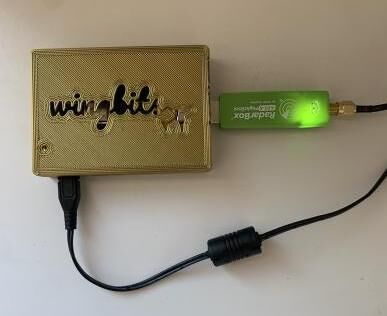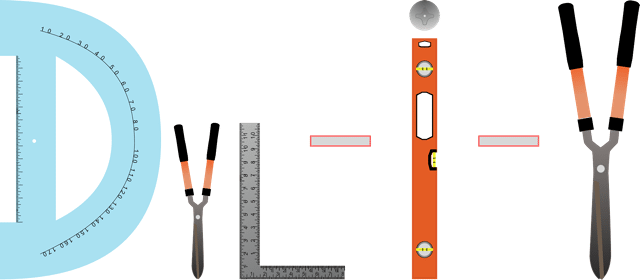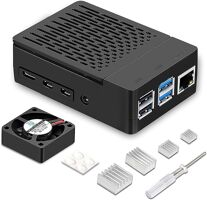September 12 2023 Looking to get started with Wingbits DePIN(Decentralized Physical Infrastructure) for flight tracking data, order all of the parts needed to build your device and get online contributing to their network of flight data, while being rewarded in the process. Skip the selection of products and check out the shopping list with all of the Wingbits hardware components. After ordering your components, be sure to head over to the Wingbits Website and join their waitlist and get a alpha device ID. Wingbits will soon offer a official Wingbits Receiver, but for now it is BYOD(Bring your own device).
Looking to get started with Wingbits DePIN(Decentralized Physical Infrastructure) for flight tracking data, order all of the parts needed to build your device and get online contributing to their network of flight data, while being rewarded in the process. Skip the selection of products and check out the shopping list with all of the Wingbits hardware components. After ordering your components, be sure to head over to the Wingbits Website and join their waitlist and get a alpha device ID. Wingbits will soon offer a official Wingbits Receiver, but for now it is BYOD(Bring your own device).
ADS-B (Automatic Dependent Surveillance-Broadcast) data serves as crucial real-time aircraft tracking information, encompassing details like aircraft position, velocity, and altitude. This data is continually transmitted by aircraft and received by both other aircraft and ground-based stations. Its importance in aviation has grown significantly due to its ability to provide accurate and current aircraft movement data, thereby enhancing air traffic management and safety.
Air Traffic Control Organizations: National and regional air traffic control entities can leverage ADS-B data to optimize traffic flow and enhance airspace safety.
Emergency Services: Police, fire departments, and other emergency services can quickly locate aircraft in distress and provide timely assistance during critical situations using ADS-B data.
Aviation Enthusiasts: Plane spotters and aviation hobbyists can use ADS-B data to track aircraft and monitor flight patterns, catering to their passion and interest.
Researchers and Academics: Scholars and researchers studying air traffic patterns, weather conditions, and other aviation-related subjects can employ ADS-B data to conduct thorough research and gain valuable insights.
In the flight tracking industry, data collection often relies on volunteers who operate receivers at their own expense. However, this approach can be perceived as inequitable. Wingbits addresses this issue by implementing a blockchain-based solution, tokenizing the data and ensuring fair and transparent rewards for data receivers based on their contributions.
Tracked Flights:
Aircraft emit signals at least once per second, providing real-time location data. Tracked Flights comprise a collection of signals emitted by an aircraft during its journey from source to destination. Each successfully received signal adds a claim to the Tracked Flight for the receiver.
Wing, their utility token, is directly linked to Tracked Flight data. One Wing is generated for every Tracked Flight and is awarded to receivers with claims on that specific flight. The reward calculation follows this formula:
Rewards = (Receiver's Claims / Total Flight Claims) * 1 Wing
For instance, if a flight has 84 claims and a receiver has registered 42 claims, they will receive 0.5 Wings. Here is my home built Wingbits receiver node(Total build cost: $110), using a Raspberry Pi 3B+($60), AirNav RadarBox Flightstick($39.95), Bingfu Dual Band 978MHz & 1090MHz Antenna($9.99)
Here is my home built Wingbits receiver node(Total build cost: $110), using a Raspberry Pi 3B+($60), AirNav RadarBox Flightstick($39.95), Bingfu Dual Band 978MHz & 1090MHz Antenna($9.99)
If using a Pi Zero 2W you will need a Micro USB to USB OTG Adapter(See below under extra parts) AirNav RadarBox Flightstick
Indoor Dual Band 978MHz & 1090MHz Antenna
Amazon Basics 128GB MicroSD Card
Micro USB to USB OTG Adapter(Necessary for Raspberry Pi Zero)
2. As of now it is a one line command that you have to run: curl -sL https://gitlab.com/wingbits/config/-/raw/master/download.sh | sudo bash
3. Once you paste the command above youu will be prompted to enter your alpha device id (Which you received via email from signing up for the beta on the Wingbits homepage)
4. After running the command above, inputting your device id and seeing "'vector active' & 'readsb active'" a reboot is usually needed to bring your device online.
5A. Head over to YOUR_DEVICE_IP_ADDRESS/graphs1090
to see receiver device data
5B. Head over to YOUR_DEVICE_IP_ADDRESS/tar1090 to see tracked flight data from your receiver
View the Wingbits flight map, see tracked flight data across their whole network, along with yours!
Don't have the parts yet? Order the components to build a Wingbits Receiver Node for just around $100.
Wingbits DePIN For Flight Tracking Data
What Does Wingbits Do?
Wingbits offers a core value by providing comprehensive flight tracking data feeds, encompassing both real-time and historical flight data, through a network of Wingbits ADS-B Receiver nodes. This data is invaluable to developers, facilitating easy integration into their applications. Anyone can set up a node, contribute to the network, and be rewarded for it. See below how you can easily build and node for just around $100.ADS-B (Automatic Dependent Surveillance-Broadcast) data serves as crucial real-time aircraft tracking information, encompassing details like aircraft position, velocity, and altitude. This data is continually transmitted by aircraft and received by both other aircraft and ground-based stations. Its importance in aviation has grown significantly due to its ability to provide accurate and current aircraft movement data, thereby enhancing air traffic management and safety.
Who Uses Wingbits Data?
Aviation Companies: Airlines, charter businesses, and other aviation-related enterprises can utilize ADS-B data to enhance their operations and offer customers more precise and up-to-date flight information.Air Traffic Control Organizations: National and regional air traffic control entities can leverage ADS-B data to optimize traffic flow and enhance airspace safety.
Emergency Services: Police, fire departments, and other emergency services can quickly locate aircraft in distress and provide timely assistance during critical situations using ADS-B data.
Aviation Enthusiasts: Plane spotters and aviation hobbyists can use ADS-B data to track aircraft and monitor flight patterns, catering to their passion and interest.
Researchers and Academics: Scholars and researchers studying air traffic patterns, weather conditions, and other aviation-related subjects can employ ADS-B data to conduct thorough research and gain valuable insights.
Wingbits Rewards
Rewards:In the flight tracking industry, data collection often relies on volunteers who operate receivers at their own expense. However, this approach can be perceived as inequitable. Wingbits addresses this issue by implementing a blockchain-based solution, tokenizing the data and ensuring fair and transparent rewards for data receivers based on their contributions.
Tracked Flights:
Aircraft emit signals at least once per second, providing real-time location data. Tracked Flights comprise a collection of signals emitted by an aircraft during its journey from source to destination. Each successfully received signal adds a claim to the Tracked Flight for the receiver.
Wing, their utility token, is directly linked to Tracked Flight data. One Wing is generated for every Tracked Flight and is awarded to receivers with claims on that specific flight. The reward calculation follows this formula:
Rewards = (Receiver's Claims / Total Flight Claims) * 1 Wing
For instance, if a flight has 84 claims and a receiver has registered 42 claims, they will receive 0.5 Wings.
Order Wingbit Device Components
You want to select one from each section, Device, ADS-B Adapter, Antenna, and MicroSD Card Here is my home built Wingbits receiver node(Total build cost: $110), using a Raspberry Pi 3B+($60), AirNav RadarBox Flightstick($39.95), Bingfu Dual Band 978MHz & 1090MHz Antenna($9.99)
Here is my home built Wingbits receiver node(Total build cost: $110), using a Raspberry Pi 3B+($60), AirNav RadarBox Flightstick($39.95), Bingfu Dual Band 978MHz & 1090MHz Antenna($9.99)Device
Raspberry Pi 4/ 3 / Zero 2W
If using a Pi Zero 2W you will need a Micro USB to USB OTG Adapter(See below under extra parts) ADS-B Adapter
AirNav RadarBox Flightstick
RTL-SDR-Blog
Nooelec NESDR Mini 2+
Antenna(Indoor & Outdoor)
Indoor Dual Band 978MHz & 1090MHz Antenna
Flightaware 1090MHz (Outdoor & Indoor) Antenna
Micro SD Card
Amazon Basics 128GB MicroSD Card
Samsung 256GB MicroSD Card
SanDisk 64GB MicroSD Card
Extra Parts And Upgrades
Micro USB to USB OTG Adapter(Necessary for Raspberry Pi Zero)
Power Supply For Raspberry Pi's
Raspberry Pi Cases
Receiver Node Setup
1. Head over to Wingbits setup page.2. As of now it is a one line command that you have to run: curl -sL https://gitlab.com/wingbits/config/-/raw/master/download.sh | sudo bash
3. Once you paste the command above youu will be prompted to enter your alpha device id (Which you received via email from signing up for the beta on the Wingbits homepage)
4. After running the command above, inputting your device id and seeing "'vector active' & 'readsb active'" a reboot is usually needed to bring your device online.
5A. Head over to YOUR_DEVICE_IP_ADDRESS/graphs1090
to see receiver device data
5B. Head over to YOUR_DEVICE_IP_ADDRESS/tar1090 to see tracked flight data from your receiver
View the Wingbits flight map, see tracked flight data across their whole network, along with yours!
Don't have the parts yet? Order the components to build a Wingbits Receiver Node for just around $100.





